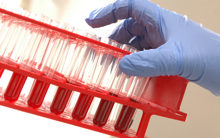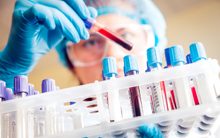On my first day working as a doctor in 1992 at Queen Mary’s Hospital, Roehampton, I was called to A&E to see a young man with sickle cell disease (SCD) – a chronic illness with symptoms including anemia and chronic pain, with risk of stroke, heart and lung problems, kidney failure and blindness. He was in severe pain and was finding it difficult to breath, so we treated him with fluids, oxygen and strong painkillers. Sadly, his condition deteriorated and he was taken to the intensive care unit, where the haematology consultant – the wonderful Dr Maitland – was called in from home to perform an exchange blood transfusion. This involved removing the patient’s sickle blood and replacing it with donated blood.
The young man recovered very quickly and the next day was chatting to us, leaving hospital after only a few days. I didn’t know that, just ten years later, I would be the consultant coming in to organise exchange transfusions and would spend most of my working life involved in the care of patients with SCD. But after my stint at QMH, I decided to train in general medicine at Queen’s Hospital, Romford and later became a specialist haematology registrar in West London.
Things have changed a great deal since my involvement with that early case, though – as with any chronic illness – we are still working to make the lives of people with SCD longer and more comfortable. Here, I want to discuss some of the major advances that have changed patient outcomes, and what exciting, life-changing treatments may be on the horizon.
Past
SCD was first described in medical literature by Dr James Herrick in Chicago in 1910, who reported the case of a dental student with anaemia and irregularly shaped, elongated blood cells. Until the 1970s, SCD was a childhood disease and the majority of those affected died of infection or other complications before they were ten.
When I first entered haematology, mortality rates had improved but treatments were not proactive. This meant patients had to have an episode – a 'crisis' – before we could treat them. Some patients had mild disease and infrequent pain, which they would manage at home. But others had frequent episodes of severe pain requiring hospital admission. We treated these more serious cases in the same way as the first patient with SCD I had met: with fluids, oxygen, pain relief and occasionally, in complicated situations, blood transfusion. Sadly, patients regularly had to wait hours for pain relief and often complained that medical and nursing staff did not believe they were in pain, instead treating them as if they were drug addicts because they were requesting morphine.
Thankfully, new approaches to treatment were on the horizon. A research trial in 1986 showed that if children with SCD were given penicillin in early life, they were less likely to die from infection. Of course you had to be able to identify which children had SCD in order to treat them, so following the trial sickle testing began to be offered as part of the newborn screening programmes. Children diagnosed in this way were offered penicillin and additional vaccines, which led to marked reductions in early death and improved survival.
The 1990s also saw the establishment of hydroxycarbamide (also known as hydroxyurea) therapy. This was the first therapy to have a proven effect on SCD – a randomised trial showed that it reduced the number of pain crises and hospital admissions for affected adults. Many more trials showing a benefit of hydroxycarbamide have been published since then, including those that demonstrate its ability to improve life expectancy. Despite this, and the existence of national and international guidelines that advocate its use, it is still under-utilised.
In 2001, I started work as a new haematology consultant in Central Middlesex Hospital in Brent with Professor Sally Davies (later Chief Medical Officer for England) and Dr Kate Ryan. Sally was an early adopter of hydroxycarbamide and the hospital had been responsible for setting up a pioneering community-based sickle cell centre in 1979 – still operating today. In the centre, a multidisciplinary team of specialist nurses and psychologists provide holistic care for patients with SCD. This is really important, as this chronic lifelong condition has a massive impact on the lives of patients and their families. They must deal with anxiety about early mortality, stigma and unpredictable severe pain episodes disrupting education and work. SCD can also impact the brain, meaning children may struggle at school and need extra help. All these factors can affect someone’s psychological and social functioning. It’s for these reasons that the holistic model of treatment has become increasingly popular.
Present
Today, over 99% of those with SCD born in the UK will survive to adulthood and mean life expectancy is in the 60s. Patients still die early and have an increasing burden of chronic disease complications as they age, but our ways of working are always improving.
For example, I now run Guy’s and St Thomas’ NHS Foundation Trust sickle cell service. Here, we have developed a multidisciplinary clinic and have a team of doctors, specialist nurses and psychologists who work together to provide inpatient and outpatient care. One of the early issues raised by our patients was the lack of a transition service for patients moving from paediatric to adult services, so we employed the first sickle cell transition nurse in the UK. In recognition of the multi-organ nature of SCD, we also developed supraspecialist clinics, where a sickle specialist works alongside a consultant from another specialty. Our specialist clinics include neurology, renal, orthopaedic, respiratory and urology clinics.
Even more exciting is the development of curative therapies. Haematopoeitic stem cell transplantation (HSCT) has become standard for children with severe disease. It uses high-dose chemotherapy and radiotherapy to destroy the patient's own stem cells (the cells in the bone marrow which make blood cells). Patients receiving this treatment are then provided with donor stem cells, which, over a few weeks, grow and start producing blood cells.
Although hydroxycarbamide is still the only drug licensed for the treatment of patients with SCD, we have worked hard to offer it to all eligible patients, with a nurse-led service providing necessary blood tests and increasing patient convenience. The only other treatment option we have to offer at the moment is blood transfusion, but rather than doing this manually as my consultant did in 1992, we can now provide automated exchange transfusions. These use machines that can perform an eight-unit blood exchange in a couple of hours. It’s not only much quicker, but is safer and causes less build-up of iron in the body (excess iron can be very dangerous and causes heart and liver problems).
Of course, not all patients with SCD are able to access specialist services like ours, but a number of initiatives have been created to tackle inequitable access and areas of poor care. Peer review of haemoglobinopathy services was started by a multidisciplinary group of health professionals in 2010 and the National Institite for Health and Care Excellence (NICE), the Sickle Cell Society and others have tried to improve quality and consistency of care by creating new guidelines and standards.
Future
Despite current limited treatment options (there have been no new treatments introduced for SCD in over two decades), the good news is that there has been lots of work leading to increased understanding of the pathophysiology of SCD. This means lots of promising new drugs in trial at the moment, hopefully some of which will become available to patients over the next few years.
Even more exciting is the development of curative therapies. Haematopoeitic stem cell transplantation (HSCT) has become standard for children with severe disease. It uses high-dose chemotherapy and radiotherapy to destroy the patient's own stem cells (the cells in the bone marrow which make blood cells). Patients receiving this treatment are then provided with donor stem cells, which, over a few weeks, grow and start producing blood cells.
Although this procedure is associated with significant side effects, the results are very good if the patient receives stem cells from a sibling with the same immunological stem cell type. The NHS does not currently fund stem cell transplants for adults with SCD, although this is offered as standard care in many other countries and I am working with NHS England to try and introduce it in the UK.
Finally, scientists have being trying to develop gene therapy in SCD for many years. Gene therapy is where some of the patient’s own stem cells are altered, either by adding a new gene or by editing the abnormal gene. There is a cell transplant, as with HSCT, but the donor cells are the patient’s own genetically modified cells. This is still an experimental procedure, but the first successful case of a cure for SCD in a 13-year-old boy was published in 2017 and there are several ongoing gene therapy trials.
All in all, this is a very exciting time to be a doctor looking after patients with SCD. After decades of providing only supportive care and very limited treatment options we are on the verge of an explosion of new treatments. Within the next decade we should have a whole host, including curative options, to help our patients live more comfortably for longer.







